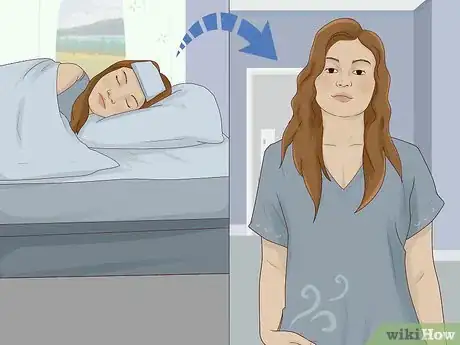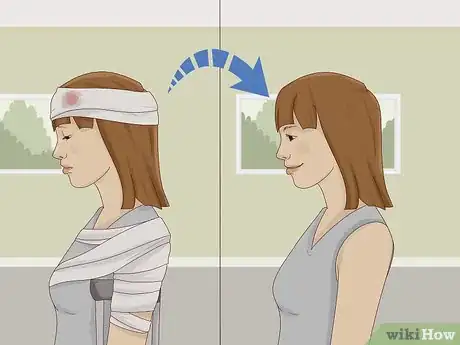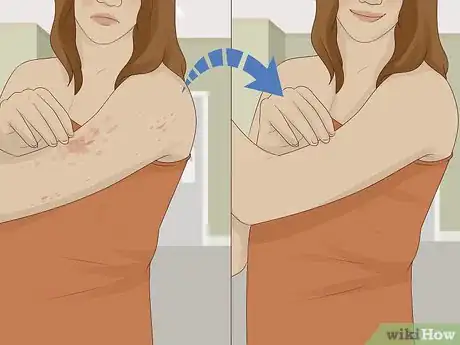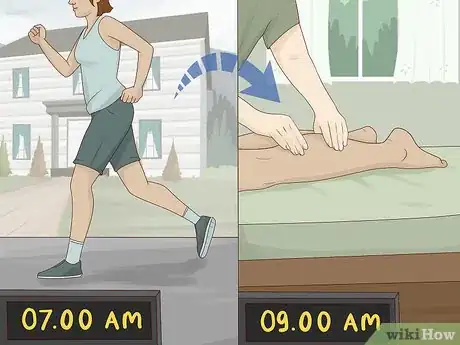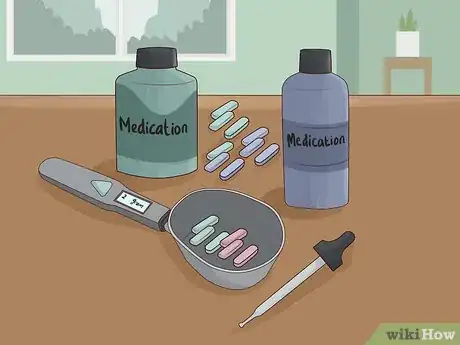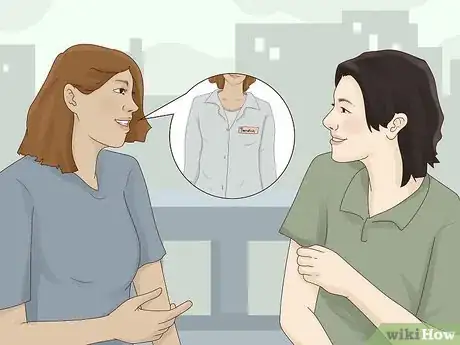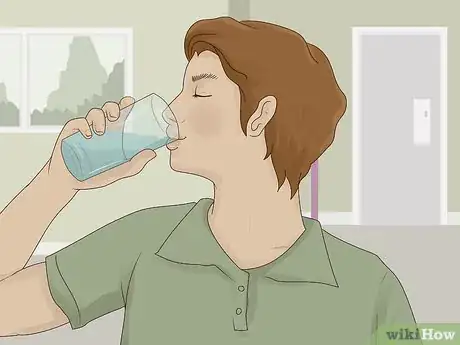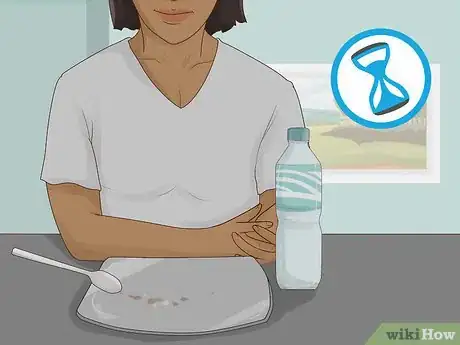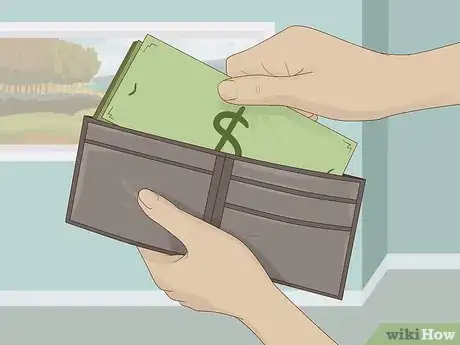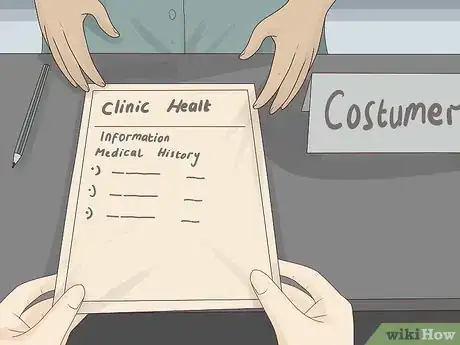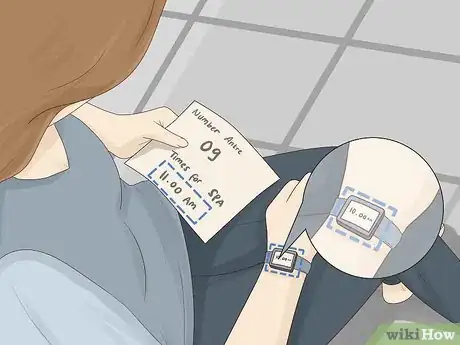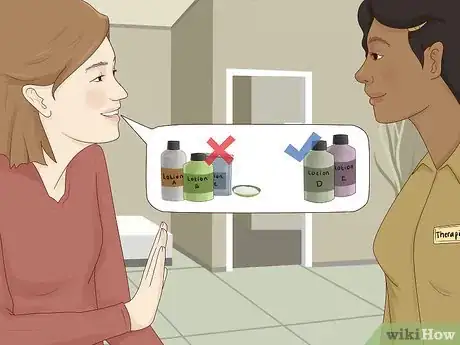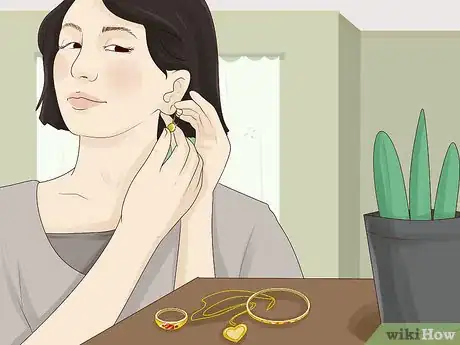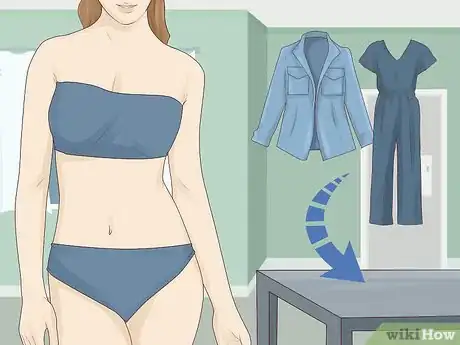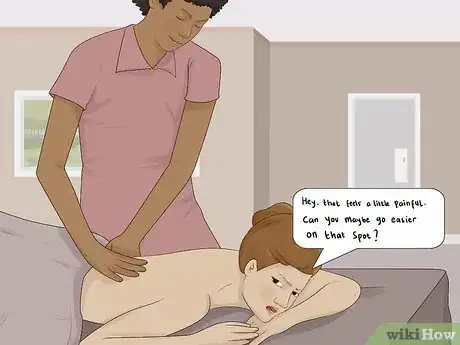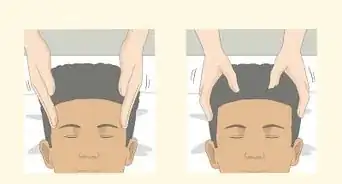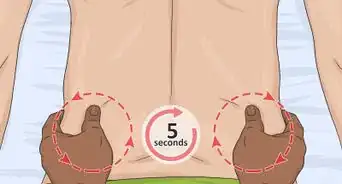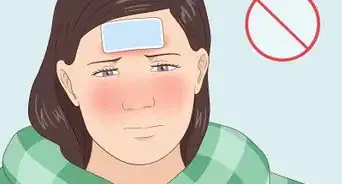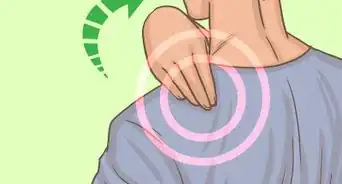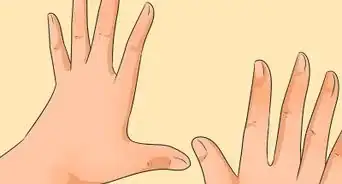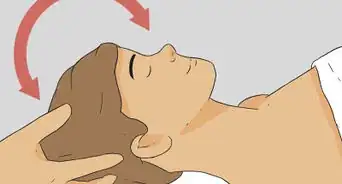This article was co-authored by Marty Morales. Marty Morales is a Professional Massage Therapist and the Founder and Owner of the Morales Method, a manual therapy and body conditioning business based in the San Francisco Bay Area and in Los Angeles, California. Marty has over 16 years of massage therapist experience and over 13 years of experience educating others on the best practices for massage therapy. Marty has over 10,000 hours of private practice logged and is a Certified Advanced Rolfer and Rolf Movement Practitioner, CMT. He has an MBA in Finance from Loyola Marymount University, Los Angeles.
There are 15 references cited in this article, which can be found at the bottom of the page.
This article has been viewed 97,223 times.
Getting a massage is a relaxing and enriching experience. However, if you've never had one, you'll want to know what you need to do. Don't worry; it's not very difficult to get ready for a massage, and even if you do something that's not quite right, your therapist will likely understand. The main rule is to relax and enjoy yourself!
Steps
Deciding When and Where to Get a Massage
-
1Skip the massage if you have a fever or you're feeling sick. You definitely don't want to make your massage therapist sick. They could pass on your illness to other patients, making lots of people sick, so it's best to stay home![1]
- Plus, some massage therapists suggest that certain types of massages stimulate your body's defenses. That may sound good, but it can make your symptoms worse and not shorten the length of the illness.[2]
-
2Wait to get a massage if you've been in a car accident or had another injury recently. If you've been in a car accident or suffered some other type of fall or accident, you may have injuries that you're not aware of yet. A massage could make that worse, particularly if you have a torn ligament or something of that nature so wait until after you've seen a doctor before you decide to get a massage. Make sure your health is in order before getting a massage.[3]
- Talk to your doctor if you've recently been in an accident so that they can clear you to see a therapist.
Advertisement -
3Avoid massages if you have skin irritation or sunburns. If you have major rashes, poison ivy, or a sunburn, you should wait until those are cleared. Having someone rub your skin and muscles will only make these worse.[4]
- Plus, you don't want to pass anything on to your therapist, even though they can use gloves.
-
4Workout before your massage, not after. A massage after working out can help with recovery. Plus, your muscles are already relaxed and warmed up for the massage. However, if you work out after your massage, you may be more prone to injury because your muscles are so relaxed.[5]
-
5Stabilize your medications before getting a massage. If you're working with a doctor to figure out the right dose for a medication, you should wait to get a massage. The deep-tissue stimulation can affect your dosages so you'll have a harder time getting them right.[6]
- Similarly, you shouldn't get a massage if you're suffering from certain conditions, such as a recent stroke or heart attack, hemorrhages, meningitis, or pneumonia. If you've had a recent illness, talk to your doctor about when it's safe to get a massage.
-
6Find a therapist who's sympathetic to your needs. When searching for a therapist, ask your friends and family for recommendations, particularly those who have similar aches, pains, and illnesses. Then, call around to ask about the therapists' specialties, style, training, years of experience, and prices.[7]
- Try to find someone with at least 500 hours of experience from an accredited school. You can check accreditation online.
- You can also check to see if they're certified by the National Certification Board for Therapeutic Massage and Bodywork or members of the American Massage Therapy Association and the Associated Bodywork Massage Professionals, both of which indicate a certain level of professionalism.
-
7Decide if you can commit to more than one session. While it's not essential to have multiple sessions, you will see a larger benefit from doing several sessions in a row, rather than a one-off session. Try a session once a week for a month, for instance, to reap the full benefits.[8]
- Some therapist may offer a small price break if you can commit to multiple sessions.
Preparing before You Get to the Spa
-
1Take a shower before you visit. Of course, you might not be able to take a shower right before you visit the massage parlor, but it is nice to take one at least within a couple of hours of your appointment. If you're coming after work or rushing from somewhere, though, your therapist will understand.[9]
- However, you don't need to worry about shaving your legs or getting a pretty pedicure. Just come as you are!
- Also, skip any perfumes, colognes, or aftershaves, which can be strong in a small room.
-
2Drink enough water to be hydrated before and after the massage. While you don't necessarily need to drink extra water, you should drink enough that you're hydrated. Staying hydrated before and after the process can only help.[10]
- Men should drink 15.5 cups (3.7 L) of water per day, while women should drink 11.5 cups (2.7 L) a day. However, if you drink when you're thirsty, you should be fine.[11]
EXPERT TIPMarty Morales is a Professional Massage Therapist and the Founder and Owner of the Morales Method, a manual therapy and body conditioning business based in the San Francisco Bay Area and in Los Angeles, California. Marty has over 16 years of massage therapist experience and over 13 years of experience educating others on the best practices for massage therapy. Marty has over 10,000 hours of private practice logged and is a Certified Advanced Rolfer and Rolf Movement Practitioner, CMT. He has an MBA in Finance from Loyola Marymount University, Los Angeles.Certified Massage Therapist
 Marty Morales
Marty Morales
Certified Massage TherapistDrink enough water and also avoid alcohol. If you have a massage on Saturday, don't drink alcohol excessively on Friday night and try not to drink any alcohol directly before the massage.
-
3Wait at least an hour after eating to get a massage. If your stomach is full, you're not going to be comfortable for your massage. Let your body have time to digest, and you'll have a much better time.[12]
- However, it's a good idea not to go to your appointment ravenous, as that will make you uncomfortable, too.
-
4Carry enough money for at least a 20% tip. Just like most areas of the service industry, it's customary to give your therapist a tip. In high-end spas, tips can even be as much as 30-40%.[13]
- Keep in mind that therapists don't work a steady 40 hours a week, so any extra is helpful.
-
5Bring information on your medical history so you can fill in the clinic's forms. You may be able to fill in these forms online ahead of time, but if you can't, you'll need to fill them out when you get there. Write in any medical conditions, along with problem areas you'd like to see addressed. Also, if you don't want any areas touched, you can note that on this form, too.[14]
- For problem areas, you might suggest you're having problems with your shoulders or you're having lower back pain, both of which the therapist can help address.
- You'll also be asked about your pain levels and what makes it better or worse.
- Have a list of the medications you're on, too.
Getting Ready at the Spa
-
1Arrive at your appointment ahead of time. If you are rushing to get there, you won't have time to calm yourself down before your massage. Being calm will help it go more smoothly. How tense or relaxed you are transfers to your muscles, and you want your muscles as relaxed as possible.[15]
- Plus, getting there early gives you time for paperwork.
-
2Make the therapist aware of any allergies you have to oils or lotions. During massages, therapists may apply oils to your skin to help with the massage process. However, if you are allergic to a certain oil, powder, or lotion, they'll switch to something else.[16]
- Your therapist will likely ask you about this, but if they don't, you can bring it up with them.
-
3Take off any jewelry you're wearing. That includes earrings, necklaces, rings, and watches. That way, your therapist can access all of your muscles without any restrictions. You may want to leave these at home to make it easier.[17]
-
4Remove only as much clothing as you'd like. You don't have to strip down for a massage. Just take off what your comfortable removing. If you want to leave most of your clothing on, be sure to pick something that's soft and comfortable.[18]
- If you decide to take off more of your clothing, keep in mind you will be covered by a sheet most of the time. The therapist will only lift the areas of the sheet to reveal the parts they need to work on.
-
5Speak up if you're uncomfortable. If something doesn't feel right or if you'd prefer they didn't touch an area that they're working on, you can speak up. Don't be afraid to communicate your wants and needs.[19]
- For instance, you might say, "Hey, that feels a little painful. Can you maybe go easier on that spot?"
Community Q&A
Did you know you can get answers researched by wikiHow Staff?
Unlock staff-researched answers by supporting wikiHow
-
QuestionI feel uncomfortable being naked for a massage so I avoid them. Any suggestions?
 wikiHow Staff EditorThis answer was written by one of our trained team of researchers who validated it for accuracy and comprehensiveness.
wikiHow Staff EditorThis answer was written by one of our trained team of researchers who validated it for accuracy and comprehensiveness.
Staff Answer wikiHow Staff EditorStaff AnswerThere are plenty of ways to get a massage without removing clothing.You can have facial, head, neck, back, arm and leg massages without removing clothes. Or, simply let the massage therapist know you are not willing to remove too much clothing and let them direct the style of massage they're able to provide for you. A good massage therapist will work around the clothing and respect your comfort levels.
wikiHow Staff EditorStaff AnswerThere are plenty of ways to get a massage without removing clothing.You can have facial, head, neck, back, arm and leg massages without removing clothes. Or, simply let the massage therapist know you are not willing to remove too much clothing and let them direct the style of massage they're able to provide for you. A good massage therapist will work around the clothing and respect your comfort levels.
References
- ↑ https://www.takingcharge.csh.umn.edu/explore-healing-practices/massage-therapy/are-there-times-when-i-shouldnt-have-massage
- ↑ https://www.sfsm.edu/massage-therapists-and-the-battle-against-cold-flu-season/
- ↑ https://www.takingcharge.csh.umn.edu/explore-healing-practices/massage-therapy/are-there-times-when-i-shouldnt-have-massage
- ↑ https://www.takingcharge.csh.umn.edu/explore-healing-practices/massage-therapy/what-can-i-expect-first-massage-theraphy-visit
- ↑ https://www.womenshealthmag.com/health/a19947320/getting-a-massage/
- ↑ https://www.takingcharge.csh.umn.edu/explore-healing-practices/massage-therapy/what-can-i-expect-first-massage-theraphy-visit
- ↑ https://www.takingcharge.csh.umn.edu/explore-healing-practices/massage-therapy/how-can-i-find-right-massage-therapist
- ↑ https://www.starkstate.edu/massage-therapy-clinic/10-tips-get-most-your-massage/
- ↑ https://www.elle.com/beauty/health-fitness/news/a14902/message-therapy-etiquette/
- ↑ https://well.blogs.nytimes.com/2015/05/22/ask-well-massage-and-toxins/
- ↑ https://www.mayoclinic.org/healthy-lifestyle/nutrition-and-healthy-eating/in-depth/water/art-20044256
- ↑ https://www.starkstate.edu/massage-therapy-clinic/10-tips-get-most-your-massage/
- ↑ https://www.elle.com/beauty/health-fitness/news/a14902/message-therapy-etiquette/
- ↑ https://www.takingcharge.csh.umn.edu/explore-healing-practices/massage-therapy/what-can-i-expect-first-massage-theraphy-visit
- ↑ https://www.starkstate.edu/massage-therapy-clinic/10-tips-get-most-your-massage/
- ↑ https://www.starkstate.edu/massage-therapy-clinic/10-tips-get-most-your-massage/
- ↑ https://www.youtube.com/watch?v=FhVzD-K2v8s&feature=youtu.be&t=24
- ↑ https://www.starkstate.edu/massage-therapy-clinic/10-tips-get-most-your-massage/
- ↑ https://www.elle.com/beauty/health-fitness/news/a14902/message-therapy-etiquette/
